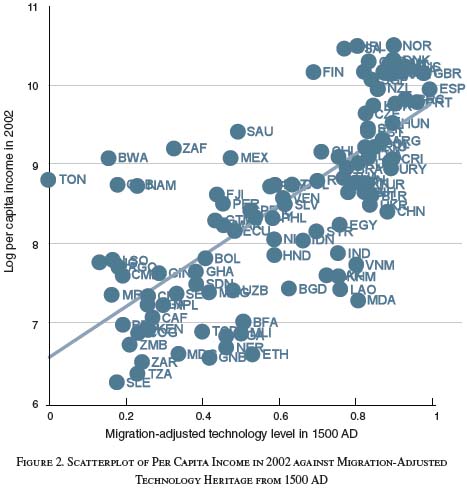By: Catherine Rampell, The New York Times
The recent finding that economic success in life is largely determined by what you learned in kindergarten has proven contentious (at least among our readers). So what if I told you that economic success was instead determined by what your ancestors did more than a millennium ago?
That is one implication of a provocative new study by Diego Comin, William Easterly (known for his skepticism of foreign aid programs) and Erick Gong.
The study gathered crude information on the state of technological development in various parts of the world in 1000 B.C.; around the birth of Jesus; and in A.D. 1500. It then compared these measures to per capita income today.
As it turns out, technology in A.D. 1500 is an extraordinarily reliable predictor of wealth today. Here’s a scatter plot showing the relationship between these two measures, in which each dot represents a different country:

By: William Easterly
As Mr. Easterly writes in an accompanying blog post, “78 percent of the difference in income today between sub-Saharan Africa and Western Europe is explained by technology differences that already existed in 1500 A.D. — even BEFORE the slave trade and colonialism.”
What’s more, these differences in technological development between regions had actually appeared as far back as 1000 B.C. (Side note: The big counterexample is China, which historically outshone other countries in its adoption of advanced technologies, but then did not go through the Industrial Revolution.)
There are multiple ways to explain persistence of technological differences over multiple millenniums.
Mr. Easterly argues that once you get on one technological track, it’s hard to switch to a new one: advanced technology begets more advanced technology, because it makes additional innovation that much easier.
“James Watt had acquired a lot of tech experience in the mining industry which he used to invent the steam engine,” Mr. Easterly writes. “Other people with the ability to make steel could then slap his steam engine on a vehicle running along steel rails and give us railroads.”
An alternate explanation was suggested by this 1999 paper, by John Luke Gallup, Jeffrey D. Sachs and Andrew D. Mellinger. For context, Mr. Sachs is often on the opposite intellectual pole of Mr. Easterly when it comes to evaluating the usefulness of foreign-development initiatives.
In this earlier paper, Mr. Sachs and his co-authors argued that geography can help determine a country’s destiny, since location and climate have significant effects on the likelihood of disease burdens, transportation costs and agricultural productivity. Malaria, for example, was an impediment to economic development in tropical several centuries ago, and it still is today. Temperate zones, on the other hand, have historically been more conducive to economic development.
Mr. Easterly’s explanation for the multimillennial gap in technology is likely more unsettling, since it implies greater challenges for future development. After all, there are many strategies that organizations like the World Bank and the International Monetary Fund can pursue to help promote a poor country’s growth, but changing a country’s past is not one of them.
Read this article on New York Times site
